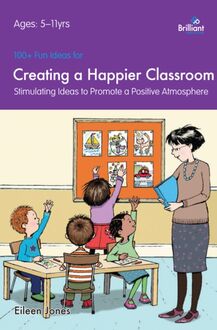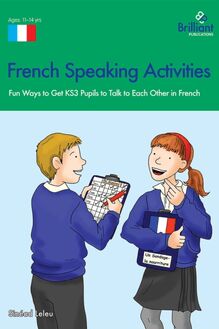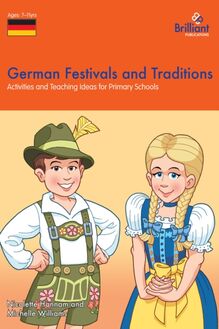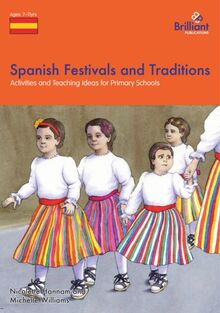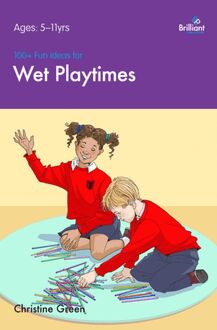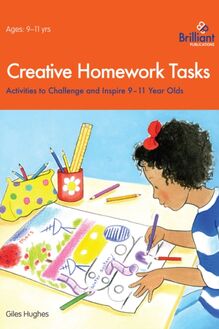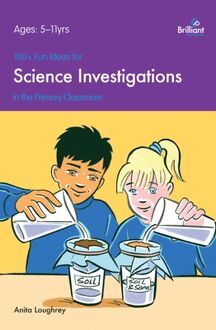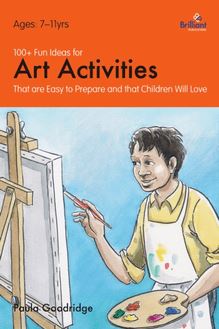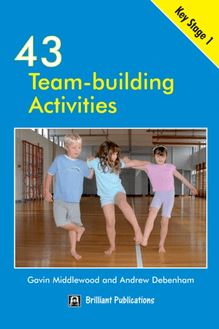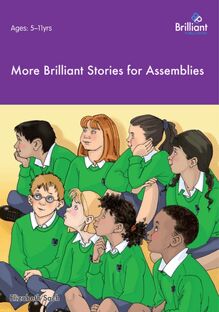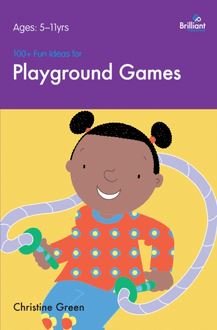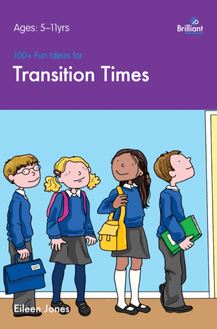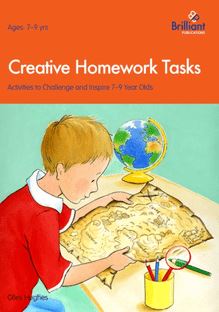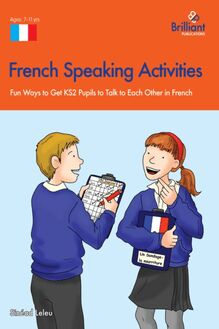100+ Fun Ideas for Modern Foreign Languages , livre ebook
75
pages
English
Ebooks
2012
Vous pourrez modifier la taille du texte de cet ouvrage
Obtenez un accès à la bibliothèque pour le consulter en ligne En savoir plus
Découvre YouScribe en t'inscrivant gratuitement
Découvre YouScribe en t'inscrivant gratuitement
75
pages
English
Ebooks
2012
Vous pourrez modifier la taille du texte de cet ouvrage
Obtenez un accès à la bibliothèque pour le consulter en ligne En savoir plus
Publié par
Date de parution
30 août 2012
Nombre de lectures
2
EAN13
9780857475398
Langue
English
Poids de l'ouvrage
1 Mo
Publié par
Date de parution
30 août 2012
Nombre de lectures
2
EAN13
9780857475398
Langue
English
Poids de l'ouvrage
1 Mo
Title page
100+ Fun Ideas for Practising Modern Foreign Languages
in the Primary Classroom
Activities for developing Oracy and Literacy skills
Sue Cave
Acknowledgement
Thank you very much to the pupils and staff at Farley Hill Primary School for allowing us to take the photos used in this book.
Legal information
Written by Sue Cave. Copyright © Sue Cave 2006
Cover and inside illustrations by Lynda Murray
Photos by Julie Thatcher. Photos copyright © Julie Thatcher 2006
Front cover designed by Brilliant Publications
First published 2006, reprinted 2007, 2008, 2009, 2010
2012 digital version by Andrews UK Limited
www.andrewsuk.com
The right of Sue Cave to be identified as the author of this work has been asserted by herself in accordance with the Copyright, Designs and Patents Act 1988.
The materials may not be reproduced in any other form or for any other purpose without the prior permission of the publisher.
Originally published by Brilliant Publications
Unit 10
Sparrow Hall Farm
Edlesborough
Dunstable
Bedfordshire
LU6 2ES, UK
E-mail: info@brilliantpublications.co.uk
Website: www.brilliantpublications.co.uk
Tel: 01525 222292
The name Brilliant Publications and the logo are registered trademarks.
Preface
This resource book is a compilation of tried and tested ideas for practising a foreign language in the primary classroom. The ideas for the activities are ones which I have devised, collected or adapted during the last ten years as a peripatetic language specialist in primary schools. I recommend them due to the response I have received from young learners and the positive impact the activities have had on their learning of another language. It is hoped that by collating these activities under one cover, they will be easily accessible for the busy teacher.
The inherent rationale behind each activity is that it is interactive, communicative, memorable and enjoyable. The most popular activities in this book invariably include at least one ‘key ingredient’, namely: manipulation a shared secret competition surprise physical movement
These ingredients make up a recipe for success!
Very few resources are needed other than the teacher, the children, paper, card and items often found in a primary school classroom. The ideas could be used as stand-alone activities throughout the school week as reinforcement of language previously encountered or as an integral part of a longer language teaching session. They are suitable for a wide variety of topics and for most modern foreign languages. Repetition and practice are essential in language learning; the variety of activities suggested in this book should provide plenty of opportunity for this.
For each resource, I have suggested ideas to develop both oracy and literacy skills. At the start of each section you will find codes relating to the oracy and literacy objectives in the ‘Key Stage 2 Framework for Languages’. There are activities related to many of these objectives across the four years in Key Stage 2. For a complete list of how the activities relate to the objectives, refer to the table in the introduction.
I hope that you have fun using and perhaps adapting these ideas in the teaching of a foreign language to your young learners. I certainly have done and continue to do so.
Sue Cave
April 2006
Introduction
Team games and competition
Many of the ideas and activities in this book suggest how a competitive element can be included. I have found that competition encourages children to participate more readily and with even greater enthusiasm than they might do otherwise. Children who seem to be reticent or appear to lack confidence in using a foreign language in the classroom, often join in with a game with relish. This seems to be true for many boys, in particular. Team games take away the emphasis from the individual. They allow children to learn, perform and develop skills in the ‘safe’ environment of a group of peers.
I avoid single sex teams but try to orchestrate mixed ability teams. These teams are normally organized on a teaching session basis and new ones formed in the next lesson. However, you could keep the same teams and develop a ‘league’ to which points are added after each game.
As in any competition, rules are essential to ensure the smooth running and fairness of the game. I tell the children that the teacher is the referee and the ‘ref’s’ decision is final! I allow the winning team to perform a victory salute and announce that they are the ‘Champions!’ in the target language. This is a privilege given only to the winners which is much respected and esteemed by all.
Team games are always popular. The children become so engrossed that they are oblivious to the amount of repetition taking place. You might guess from all this, that I like team games and find them an effective strategy in language learning. However, if you feel that it would be more appropriate for your class to learn in a less competitive atmosphere, the majority of the activities can be played just as well without explicit competition.
Key Stage 2 Framework for Languages Objectives
Objective
Activity number
O3.1
1, 2, 40, 114, 115, 116
O3.2
42, 62, 63, 67, 77, 117, 120
O3.3
8, 9, 10, 11, 12, 13, 14, 15, 16, 17, 34, 35, 36, 46, 47, 48, 50, 56, 57, 58, 59, 60, 76, 79, 80, 81, 82, 83, 85, 86, 87, 105, 106, 107, 108
O3.4
3, 4, 5, 6, 7, 44, 45, 65, 67, 68, 69, 70, 71, 72, 73, 74, 75, 76, 84
L3.1
19, 20, 24, 27, 98, 109
L3.2
30
L3.3
39, 100, 101
O4.1
118, 120
O4.2
44, 45
O4.3
41, 43, 67
O4.4
18, 31, 32, 37, 49, 61, 63, 64, 78, 88, 89, 90, 91, 92, 94, 95, 96, 97
L4.1
22, 23, 29, 103, 104, 109
L4.2
21, 25, 26, 28, 113
L4.3
102
L4.4
39, 54, 103, 104, 125, 129
O5.1
31, 51
O5.2
33, 89, 93
O5.4
119, 121, 122, 123, 124
L5.2
66, 99, 110, 111, 112
L5.3
55, 103, 104, 126, 127, 128, 130, 131
O6.2
38, 51, 52, 53, 119, 121, 124
L6.1
135, 137
L6.4
132, 133, 134, 135, 136, 137
Flashcards
Flashcards are an excellent way of bypassing the mother tongue and encouraging the use of the target language. They are very versatile and can be used in many activities.
Flashcards can easily be made from images, either hand-drawn, collected from magazines, or using ‘clipart’ obtained either online or from commercially produced software. Home-produced images need to be strengthened with card and laminating will increase their durability. The flashcards can be colour coded as a prompt for remembering the gender of nouns. Alternatively, coloured stickers could be used.
A5 size is normally big enough for all to see in a classroom. Smaller cards are better for group work.
Year 3 children playing ‘Match the word to the image’
Oracy
O3.1, O3.3, O3.4, O4.4
In the following activities, flashcards provide cues for oral repetition, simple communicative tasks and demonstrating recognition.
Responding to rhymes, stories and songs
1. Listen and show Create images on cards which relate to key words and sounds in rhymes, stories and songs. Distribute the cards amongst the children and then ask them to raise the cards showing the corresponding image as the words are recited in the story, song or rhyme.
2. Card sequencing Put the children in groups. Give the children small versions of the cards from activity 1, relating to key words and sounds in rhymes, stories and songs. Ask them to sequence the cards as they hear them.
Listening, recognizing and responding to sounds and words
3. Point to a card Position the cards around the room. Say a word and then ask the children to point to the correct image. The children love it when you speed up this activity and keep repeating the same word or sound in succession.
4. Clap if true Show a card and say a word. If the word matches the card, the children either clap, say ‘true’, stand up or nod, etc. This is a good game to play competitively, with the children versus the teacher, awarding a point to the te
